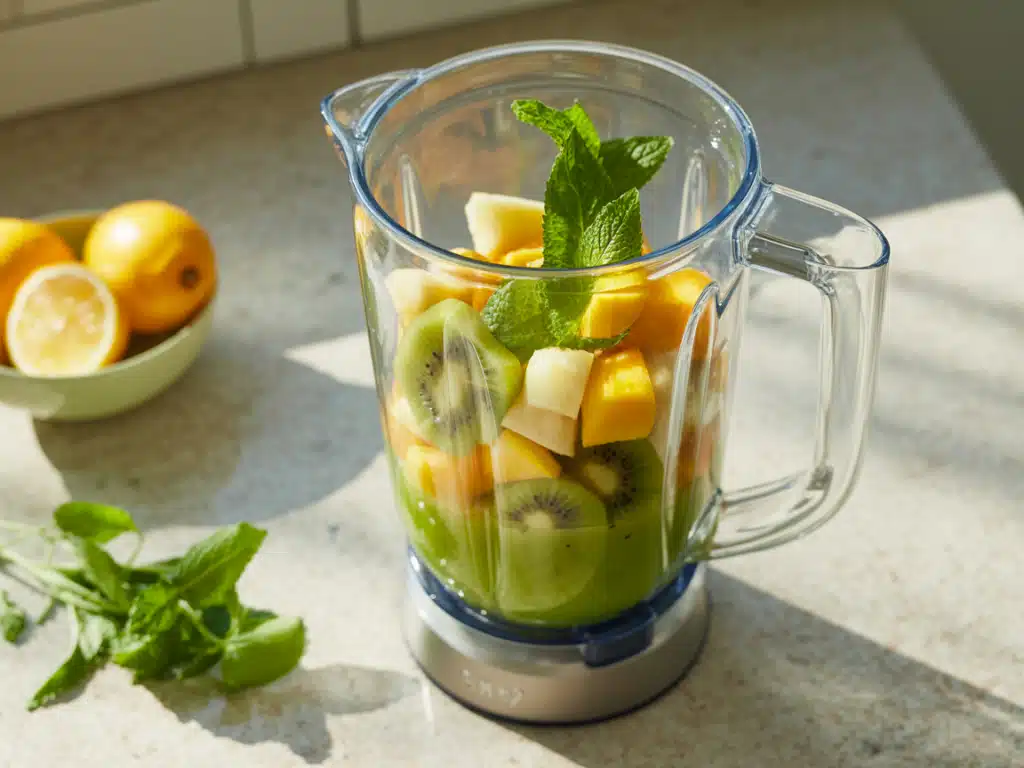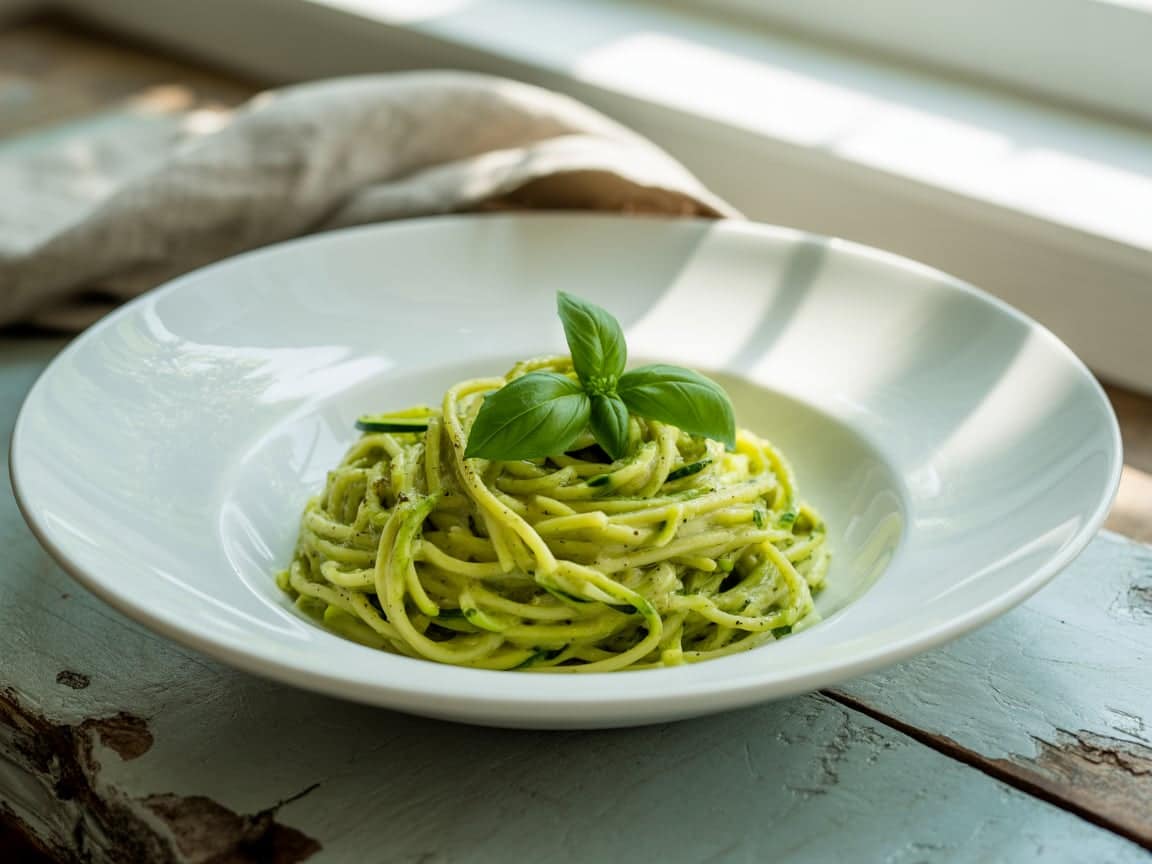Lemon balm recipe—just the mention of it brings back memories of my grandmother’s warm kitchen, where I first fell in love with simple herbs that brought big comfort. I’m Sarah, the heart behind CozyBitesRecipes.com, and this site was born from those early days spent barefoot, apron-tied, and enchanted by the aromas of homemade goodness. As a mom of two now, the kitchen remains the heartbeat of my home—where comfort meets creativity and every recipe carries a story.
At Cozy Bites, it’s not just about putting meals on the table—it’s about stirring up joy, connection, and those quiet moments of “mmm, that’s good.” And when it comes to natural comfort, lemon balm is a star. From soothing sips to zesty boosts, this versatile herb deserves a spotlight in your kitchen.
In this article, we’re diving deep into the world of lemon balm: what it is, how to use it, why it helps with everything from stress to digestion—and most of all, how to make a refreshing and easy lemon balm recipe that might just become your new favorite ritual.
Check out this detox idea: Natural Zepbound Recipe
Table of Contents
Understanding Lemon Balm and Its Culinary Potential
What is Lemon Balm? (History & Herb Profile)
Lemon balm (Melissa officinalis) is a bright, lemon-scented herb from the mint family that has been cherished for centuries. It traces its roots to the Mediterranean, where ancient Greek and Roman herbalists praised its calming effects. Traditionally used to treat everything from sleeplessness to digestive trouble, lemon balm has stood the test of time as both a remedy and a flavor enhancer—especially in a well-crafted Lemon Balm Recipe.
Today, you’ll find it in herbal teas, tinctures, essential oils, and increasingly in modern kitchens. Whether steeped in tea or blended into sauces, a Lemon Balm Recipe makes use of its light citrus aroma and subtle minty finish, making it a natural match for both sweet and savory dishes.
What makes lemon balm stand out is its naturally occurring compounds like rosmarinic acid and eugenol, which support relaxation and inflammation reduction. That’s why so many people turn to a Lemon Balm Recipe for stress relief, mental clarity, and digestive health.

Benefits of Lemon Balm Recipe in Culinary Uses
Beyond its herbal wellness perks, lemon balm shines as a culinary companion. You can use it dried or fresh, depending on the Lemon Balm Recipe and the season. Fresh leaves offer brighter, zestier notes, while dried lemon balm delivers a deeper, more concentrated flavor.
Here’s how lemon balm makes a splash in everyday cooking:
| Culinary Use | Why It Works |
|---|---|
| Herbal Teas | Light, calming flavor perfect for sipping. |
| Salads & Dressings | Adds citrusy lift to green or grain salads. |
| Butters & Pestos | Infuses fresh lemony flavor in spreads. |
| Baked Goods | Enhances muffins, scones, and tea cakes. |
| Smoothies | Freshens up fruit blends naturally. |
When combined with lemon, honey, or even mint, lemon balm truly shines. Whether you’re brewing it into a healing infusion or tossing it into a summer salad, this herb is as functional as it is flavorful.
Looking for inspiration? Try: Purple Peel Recipe
Core Lemon Balm Recipes You Should Try
Simple Lemon Balm Tea: Classic Herbal Infusion
One of the easiest and most effective ways to enjoy lemon balm is by turning it into a soothing tea. Whether you’re winding down at night or seeking relief from stress, lemon balm recipe tea delivers comfort in every sip.
Here’s how to make it:
Basic Lemon Balm Tea Recipe
- 1 tablespoon dried lemon balm (or 3 tablespoons fresh)
- 1–2 cups boiling water
- Optional: honey, lemon slice, or fresh mint
Steps
- Place the lemon balm leaves in a tea infuser or heat-proof mug.
- Pour hot water over the herbs.
- Steep for 10–15 minutes, then strain and sweeten if desired.
- Sip slowly and enjoy the calming aroma.
This tea helps reduce anxiety, supports digestion, and promotes restful sleep—no wonder it’s a bedtime favorite for many.
Lemon Balm Pesto, Syrups, and Butters
Lemon balm isn’t limited to tea. With its zesty character, it’s a hidden gem in recipes like pesto, herb-infused syrup, and compound butters that can transform everyday meals.
Lemon Balm Pesto
Replace basil with lemon balm for a citrusy twist. Blend with olive oil, garlic, Parmesan, and pine nuts to spread on toast, swirl into pasta, or drizzle on grilled chicken.
Lemon Balm Syrup
Simmer lemon balm with sugar and water for 10 minutes to create a versatile syrup perfect for lemonades, cocktails, or even pancakes.
Lemon Balm Butter
Finely chop fresh leaves and mix with softened butter, lemon zest, and a pinch of sea salt. Use it on grilled fish, corn on the cob, or warm bread.
These creative uses elevate your meals while making full use of your garden herbs.
Don’t miss our wellness mix: Natural Mounjaro Recipe
Ultimate Lemon Balm Drink Recipe (Step-by-Step Guide)
Ingredients Breakdown & Substitutes
This refreshing lemon balm drink is a go-to herbal infusion that’s not only hydrating but also packed with soothing benefits. Here’s what you’ll need to make it—and some handy swaps if you don’t have everything on hand.
| Ingredient | Amount | Substitute Options |
|---|---|---|
| Filtered water | 2 cups | Spring water or coconut water |
| Fresh lemon balm leaves | 3 tablespoons (or 1 tbsp dried) | Mint leaves (for a slightly different profile) |
| Fresh lemon juice | 2 teaspoons | Lime juice |
| Honey (optional) | 1 teaspoon | Maple syrup or agave |
| Ice cubes (optional) | As needed | Frozen lemon slices |
| Lemon slices (for garnish) | Optional | Cucumber or lime slices |
Using fresh lemon balm will give you a vibrant, citrusy flavor, but dried works great too—just reduce the amount to keep the taste balanced.
Instructions with Preparation Tips
Follow this simple method to craft a refreshing Lemon Balm Recipe you can enjoy anytime—especially during warm afternoons or after a long day.
Step 1: Boil the Water
Begin your Lemon Balm Recipe by bringing 2 cups of filtered water to a gentle boil. This only takes about 2–3 minutes.
Step 2: Steep the Lemon Balm
Add fresh or dried lemon balm leaves to a heat-safe jar or mug. Pour the hot water over the herbs, cover with a lid or plate, and let steep for 10–15 minutes. The longer you steep, the stronger the flavor and health benefits of your Lemon Balm Recipe.
Step 3: Strain and Cool
Strain out the leaves and allow the liquid to cool to room temperature—about 5–10 minutes. This step enhances the clean, crisp flavor of your homemade Lemon Balm Recipe.
Step 4: Add Lemon & Optional Sweetener
Stir in fresh lemon juice and honey (if using). Mix well until the honey is fully dissolved, adding a hint of sweetness to this vibrant Lemon Balm Recipe.
Step 5: Chill & Serve
Pour the drink over ice. Garnish with lemon slices or herbs if desired. Enjoy your Lemon Balm Recipe immediately or refrigerate for up to 24 hours for later refreshment.
Total Time: ~25 minutes
Calories: Only 15 kcal per serving
This drink is the perfect blend of citrus and herbal notes—light, clean, and incredibly soothing. Add it to your evening wind-down routine or sip it mid-morning for a gentle boost.
Don’t miss this herbal boost: Pink Salt Recipe
Print
Lemon Balm Recipe
A refreshing herbal drink made with lemon balm, lemon juice, and a touch of honey. Perfect for calming your day naturally.
- Total Time: 17 min
- Yield: 1–2 servings 1x
Ingredients
2 cups filtered water
1 tablespoon dried lemon balm leaves or 3 tablespoons fresh lemon balm leaves
2 teaspoons fresh lemon juice
1 teaspoon honey (optional, for a touch of sweetness)
Ice cubes (optional, for serving)
Lemon slices (optional, for garnish)
Instructions
Boil the water: In a small pot or kettle, bring 2 cups of filtered water to a gentle boil. (2-3 minutes)
Steep the lemon balm: Add the lemon balm (dried or fresh) to a heat-safe jar or mug. Pour the hot water over it, cover, and steep for 10–15 minutes.
Strain and cool: Strain out the leaves and let the infusion cool to room temperature. (5–10 minutes)
Add lemon and optional sweetener: Stir in fresh lemon juice and honey if using. Mix well.
Chill and serve: Pour over ice, garnish with lemon slices, and enjoy immediately or refrigerate for up to 24 hours.
Notes
Fresh vs Dried: Fresh lemon balm has a brighter, greener flavor, while dried is more concentrated, both work beautifully.
Make Ahead: Prepare a larger batch and store in the fridge for up to 2 days.
Flavor Boosts: Add a slice of cucumber or a few fresh mint leaves for extra freshness.
No honey? You can substitute with a drop of stevia or skip sweetener entirely.
- Prep Time: 15 min
- Cook Time: 2 min
- Category: Drinks
- Cuisine: Herbal / Wellness
- Diet: Gluten Free
Nutrition
- Calories: 15 kcal
Health Benefits of Drinking Lemon Balm
Does Lemon Balm Help Lose Belly Fat?
If you’re exploring natural ways to support weight loss, lemon balm may offer a subtle but helpful assist. While not a magic bullet, it contributes to weight management by:
- Reducing stress-related eating: Lemon balm helps lower cortisol levels, which can reduce cravings and emotional snacking.
- Improving digestion: A healthy gut and less bloating can create a flatter stomach appearance.
- Supporting sleep quality: Poor sleep is linked to weight gain. Lemon balm’s calming effects promote better rest, which indirectly supports fat loss goals.
Though research is still ongoing, its metabolism-supporting and anti-inflammatory properties suggest that regular intake of a lemon balm recipe, particularly in tea or drink form, may contribute to belly fat reduction over time when combined with a healthy diet and lifestyle.
Stress Relief, Digestion, and Sleep Benefits
Drinking lemon balm isn’t just tasty—it’s a wellness ritual.
1. Stress Relief & Anxiety Reduction
Lemon balm has been used for centuries as a natural calming agent. It contains rosmarinic acid, which may boost GABA activity in the brain, resulting in reduced anxiety and a sense of calm.
A cup of lemon balm tea or a refreshing chilled drink can:
- Help you unwind after a stressful day
- Reduce nervous tension
- Improve mental clarity and focus
2. Improved Digestion
Lemon balm stimulates bile flow and relaxes the muscles of the gastrointestinal tract. This means:
- Relief from bloating and indigestion
- Eased stomach cramps or discomfort
- Enhanced nutrient absorption
3. Better Sleep Quality
Insomnia and restless nights are often tied to stress. Lemon balm’s relaxing properties can help:
- Fall asleep faster
- Stay asleep longer
- Wake up feeling refreshed
For even better results, combine lemon balm with other sleep-enhancing herbs like chamomile or valerian in your nightly tea blend.
Don’t miss this botanical boost: Brazilian Mounjaro Recipe
Other Creative Uses of Lemon Balm in Recipes
Lemon Balm in Salads, Smoothies, and Soups
Lemon balm is far more versatile than most people realize. Sure, it makes a calming tea, but that’s just scratching the surface. This fragrant herb adds a citrusy zing to many dishes—and can be the star of a creative Lemon Balm Recipe, both sweet and savory.

1. In Fresh Salads
Toss finely chopped lemon balm into green or grain salads as part of a light, refreshing Lemon Balm Recipe. It pairs especially well with arugula, spinach, cucumbers, berries, and citrus vinaigrettes. Its brightness balances peppery or earthy flavors.
Tip: Combine lemon balm with fresh mint, basil, and feta for a Mediterranean-inspired Lemon Balm Recipe that bursts with flavor.
2. Blended into Smoothies
Add a few leaves to your morning smoothie to create a naturally energizing Lemon Balm Recipe. It blends well with fruits like mango, pineapple, strawberries, or banana. Not only does it enhance flavor, but it also adds anti-inflammatory and digestive benefits to your blend.
Try this:
- ½ banana
- ½ cup Greek yogurt
- ½ cup almond milk
- Handful of spinach
- 3–5 lemon balm leaves
- 1 tsp honey
- Blend and enjoy!
3. Stirred into Soups
Add lemon balm to vegetable soups, chicken broth, or lentil stews just before serving. It enhances the aroma and gives your dish an unexpected lift.
Pro Tip: Use lemon balm like fresh parsley—add it last so the flavor doesn’t fade with heat.
Preserving Lemon Balm: Freezing, Drying, Infusing
To keep lemon balm around even when it’s out of season, you can preserve it with simple techniques that lock in both flavor and benefits.
1. Freezing
Wash and chop fresh lemon balm, then place it in ice cube trays with water or olive oil. Freeze and store for up to 3 months. These cubes are great for teas, soups, or sautés.
2. Drying
Tie bunches of lemon balm and hang upside down in a dry, shaded area for 7–10 days. Once brittle, crumble and store in airtight jars for tea blends or dry rubs.
3. Infusing
Make lemon balm oil by steeping clean, dried leaves in a jar of olive oil for 2–3 weeks. It makes a lovely massage oil or addition to salad dressings.
Using these methods, you can enjoy the calming, citrus-kissed essence of lemon balm all year long.
Best Ways to Consume Lemon Balm Safely
How Much is Too Much? Dosage Guidelines
Like most herbs, lemon balm is powerful in small doses but should be consumed thoughtfully. While it’s safe for most people, sticking to recommended amounts ensures you enjoy its benefits without unwanted side effects.
General Guidelines for Lemon Balm Use:
| Form | Safe Daily Amount |
|---|---|
| Dried leaf (tea) | 1–2 teaspoons per cup, up to 3 cups daily |
| Fresh leaf (food use) | Up to ¼ cup per recipe |
| Extracts/capsules | 300–600 mg up to 3x/day (follow label) |
| Tincture | 2–3 ml up to 3x/day |
Overuse—especially in concentrated forms—can cause mild drowsiness, nausea, or dizziness. It’s always smart to start small and observe how your body responds.
Who Should Avoid Lemon Balm? Warnings & Interactions
While lemon balm is generally safe and often used in a variety of Lemon Balm Recipe preparations, certain groups should be cautious:
1. Pregnant or Breastfeeding Women
There’s limited research on the effects of lemon balm during pregnancy or lactation. While culinary amounts in a mild Lemon Balm Recipe are usually fine, concentrated teas or supplements should be avoided unless approved by a healthcare provider.
2. People with Thyroid Disorders
Lemon balm may suppress thyroid function in large doses. If you have hypothyroidism or take thyroid medications, speak with your doctor before making a Lemon Balm Recipe part of your daily routine.
3. Sedative or Anxiety Medication Users
Lemon balm may increase the effects of sedatives or anxiety meds, potentially leading to excessive drowsiness. If you’re on such medications, monitor your response to any Lemon Balm Recipe, especially teas or tinctures. Use with caution and under medical supervision if you’re on medications like:
- Valium (diazepam)
- Ativan (lorazepam)
- Ambien (zolpidem)
4. Surgery Preparation
Avoid lemon balm at least two weeks before surgery, as it might affect central nervous system function when combined with anesthesia.
Bottom Line: If you’re healthy and use lemon balm in food or tea, it’s safe and beneficial. But when in doubt—especially with medical conditions—ask your healthcare provider.
Growing and Harvesting Fresh Lemon Balm
How to Grow Lemon Balm at Home (Indoor/Outdoor)
One of the best things about lemon balm recipe is how incredibly easy it is to grow. Whether you’re planting in a backyard garden or a sunny windowsill, this herb thrives with very little fuss.

Growing Lemon Balm Outdoors:
- Soil: Prefers well-drained, slightly sandy soil with moderate nutrients.
- Sunlight: Full sun to partial shade; it loves light but can tolerate a bit of shade.
- Water: Keep soil moist but not soggy. Water regularly, especially in hot weather.
- Spacing: Space plants about 18–24 inches apart—lemon balm spreads quickly!
Pro Tip: Plant it in containers to keep it from taking over your garden beds.
Growing Lemon Balm Indoors:
- Potting: Use a container with drainage holes and rich potting mix.
- Light: Place near a sunny window that gets at least 5–6 hours of light.
- Maintenance: Pinch back leaves to encourage bushier growth. Rotate the pot weekly to ensure even sun exposure.
Bonus Tip: Lemon balm also makes a great companion plant. It naturally repels mosquitoes and attracts pollinators like bees.
Best Times to Harvest for Optimal Flavor
Timing is key when harvesting lemon balm to capture its strongest flavor and essential oils.
- When to Harvest: Just before the plant blooms—usually late spring or early summer—is the best time. The leaves are most fragrant and potent then.
- How to Harvest: Use clean scissors or garden shears to cut stems just above a leaf node. This encourages new growth and fuller plants.
- How Often: You can harvest lemon balm several times in a season. Regular pruning actually helps it grow stronger and bushier.
After harvesting, you can:
- Use it immediately in teas or recipes.
- Dry it for later use in herbal blends.
- Infuse it into oils or syrups.
By growing your own lemon balm, you ensure a fresh, sustainable supply for teas, tonics, and dishes—plus, it adds life and greenery to your kitchen space.
Frequently Asked Questions About Lemon Balm Recipe
What Can You Make with Lemon Balm?
Lemon balm is a surprisingly versatile herb. Beyond the classic lemon balm tea, you can create:
Infused waters and mocktails for a refreshing twist.
Herbal syrups that pair well with pancakes or cocktails.
Smoothies that benefit from a citrusy, minty layer.
Compound butters or pesto for bread, seafood, or pasta.
Homemade salves and balms, thanks to its skin-soothing properties.
It’s not just for drinking—lemon balm can brighten everything from desserts to savory spreads.
Does Lemon Balm Help Lose Belly Fat?
While lemon balm won’t directly “melt belly fat,” it does support your overall wellness, which contributes to healthy weight management:
It reduces stress hormones (like cortisol), which are linked to belly fat.
It supports digestive health and reduces bloating.
It may improve sleep quality, which is key to regulating metabolism.
Combined with balanced eating and regular movement, a lemon balm recipe can be part of a smart weight-loss strategy.
What Is the Best Way to Consume Lemon Balm?
The best way really depends on your goal:
For calm and relaxation: Brew it as tea or make a cool lemon balm drink.
For culinary use: Chop fresh leaves into salads or pestos.
For medicinal benefits: Use a tincture or extract in small amounts.
However, for most people, drinking it as tea or in a chilled lemon balm infusion offers the most benefits with the least preparation.
How to Make a Lemon Balm Drink?
It’s easy! Follow this quick recipe:
Ingredients
2 cups hot filtered water
3 tbsp fresh lemon balm (or 1 tbsp dried)
2 tsp lemon juice
1 tsp honey (optional)
Ice & lemon slices for garnish
Steps
Steep lemon balm in hot water for 10–15 minutes.
Strain, cool to room temp.
Add lemon juice and honey.
Pour over ice, garnish, and enjoy!
It’s refreshing, low in calories, and ideal for a summer day—or anytime you need a calming herbal boost.
Final Thoughts on Using Lemon Balm Recipe in Your Daily Diet
Why You Should Add Lemon Balm Recipe to Your Routine
Whether you’re sipping it in tea, blending it into a smoothie, or infusing it in a refreshing drink, lemon balm is one of those humble herbs with real, feel-good power. Its light citrus-mint flavor makes it easy to love, and its health perks—like calming your nerves, soothing digestion, and improving sleep—make it worth keeping on hand.
From my own kitchen to yours, I can confidently say that a simple lemon balm recipe can turn an ordinary day into something soothing, refreshing, and even a little magical. With just a few fresh leaves and common pantry ingredients, you’re crafting more than a drink—you’re creating a ritual of wellness and comfort.
Easy Lemon Balm Recipe Ideas to Get You Started
If you’re ready to explore lemon balm recipe further, here are quick ideas to try:
- Morning calm: Brew hot lemon balm tea with honey and ginger.
- Afternoon chill: Make the iced lemon balm drink recipe in this article.
- Evening unwind: Pair with chamomile for a nighttime blend.
- Flavor twist: Chop into cucumber salad or stir into chilled soups.
- Sweet treats: Infuse it into sugar syrups for lemonade or glazes.
Start small, sip slowly, and let lemon balm recipe become your secret ingredient for calm and connection.
Check out our other natural sips: Pink Salt Recipe




